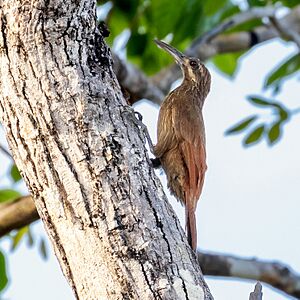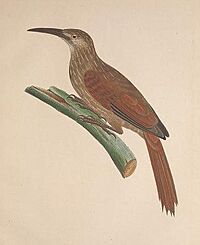Moustached woodcreeper facts for kids
Quick facts for kids Moustached woodcreeper |
|
|---|---|
 |
|
| Conservation status | |
| Scientific classification | |
| Genus: |
Xiphocolaptes
|
| Species: |
falcirostris
|
 |
|
The moustached woodcreeper (Xiphocolaptes falcirostris) is a special kind of bird that lives only in Brazil. It's called "moustached" because of the stripes on its face that look a bit like a mustache! This bird is part of the ovenbird family, and sadly, it's considered a Vulnerable species, meaning its numbers are getting low.
Contents
About the Moustached Woodcreeper
Scientists give every living thing a unique name, like a first and last name, to help identify them. This is called taxonomy. The moustached woodcreeper's scientific name is Xiphocolaptes falcirostris.
There are two slightly different types, or "subspecies," of the moustached woodcreeper:
- X. f. falcirostris
- X. f. franciscanus
Sometimes, scientists have debated if X. f. franciscanus should be its own species or even a type of another woodcreeper. It's all part of how scientists figure out the family tree of animals!
What Does It Look Like?
The moustached woodcreeper is one of the biggest birds in its group. It's a strong bird with a short tail and a long, thin beak. It grows to be about 28 to 32 centimeters (11 to 13 inches) long and weighs around 110 grams (3.9 ounces). Both male and female birds look the same.
Here's how you can spot one:
- Face: It has a brown face with light, creamy stripes above its eyes and near its beak, looking like a "mustache."
- Head: Its head is cinnamon-brown to dark olive-brown with thin, light streaks.
- Body: Its back is reddish-brown, and its wings and tail are a brighter reddish-orange.
- Underparts: Its throat is pale and creamy, and its belly is light brown. Its sides might have faint light streaks.
- Eyes, Beak, and Legs: It has dark reddish eyes, a dark gray upper beak, a pale gray lower beak, and olive-gray legs.
Young moustached woodcreepers look similar to adults but have darker streaks on their bellies. The X. f. franciscanus subspecies usually has a shorter tail and a longer beak, and its belly is darker and more olive-colored.
Where Do Moustached Woodcreepers Live?
This bird lives only in the northeastern and eastern parts of Brazil.
- The X. f. falcirostris subspecies is found in states like Maranhão, Piauí, and Bahia. It lives in specific spots within these areas.
- The X. f. franciscanus subspecies lives west of the São Francisco River in western Bahia and northern Minas Gerais.
Moustached woodcreepers like to live in forests where trees lose their leaves (deciduous) or partly lose them (semi-deciduous). They also live in wooded areas called caatinga and forests along rivers (gallery forests). They prefer the inside of healthy forests, especially where the trees are tallest. They usually live below 500 meters (1,600 feet) in elevation, but sometimes they can be found as high as 800 meters (2,600 feet).
Behavior and Daily Life
Movement and Home Life
The moustached woodcreeper stays in the same area all year round. It doesn't migrate to different places.
What Do They Eat?
These birds mostly eat insects, but they have also been seen eating snails. They usually look for food alone, in pairs, or sometimes in small family groups. They don't join large groups of different bird species when foraging. They also don't follow swarms of army ants, which many other birds do to find food.
They search for food from the middle to the top of the trees, but sometimes they look on the ground too. They climb along tree trunks and branches, poking their long beaks into holes, under bark, and especially into plants like bromeliads to find hidden snacks.
Reproduction and Family Life
Scientists believe that moustached woodcreepers breed during the southern summer, which is roughly from October to December. No one has found a nest yet, so we don't know how many eggs they lay, how long the eggs take to hatch, or how long it takes for the young birds to leave the nest.
However, both male and female birds have been found with "brood patches" – a bare patch of skin on their belly that helps keep eggs warm. This suggests that both parents help incubate the eggs and care for the baby birds.
What Do They Sound Like?
The moustached woodcreeper has a unique song. It's a series of 4 to 7 double-notes that sound like "wèèè-TJUH wèèè-TJUH." These notes often change gradually to "Tu-Tjuh." Its call is a "whining, drawn-out 'wèèè-tuh'," where the "tuh" part is high and dry.
Why Is It Vulnerable?
The IUCN (International Union for Conservation of Nature) first listed the moustached woodcreeper as "Threatened" and then changed its status to "Vulnerable" in 1994. This means the species is at high risk of becoming endangered in the wild.
Even though it lives in a fairly large area, it's only found in scattered spots. Scientists estimate there are only between 2,500 and 10,000 adult birds left, and their numbers are still going down.
The main reason for this decline is the widespread destruction of dry forests in Brazil. This has quickly reduced the bird's population. The remaining groups of birds are now separated from each other, making it harder for them to thrive.
The moustached woodcreeper is considered uncommon to rare and very local. Luckily, it is legally protected in Brazil, and conservation efforts have helped set aside some important areas as parks and reserves to protect these special birds.



